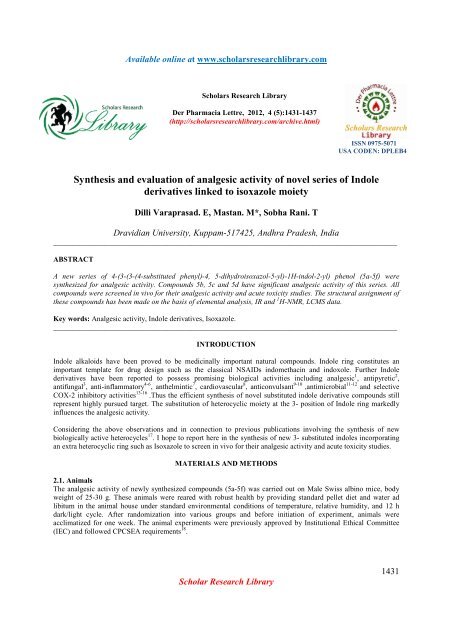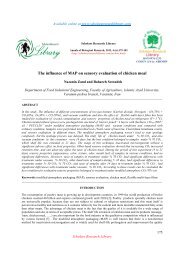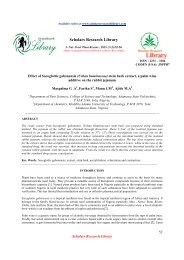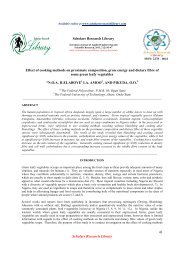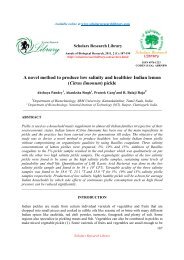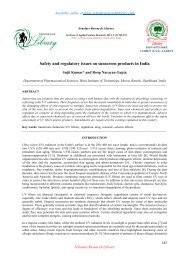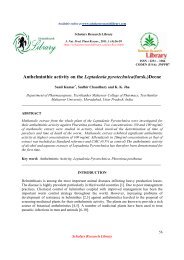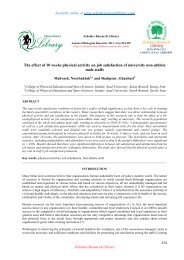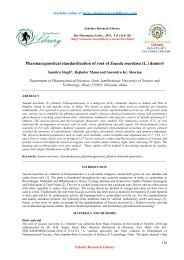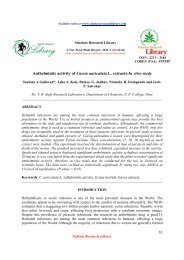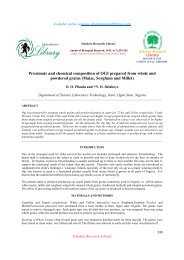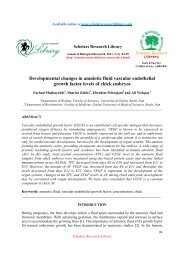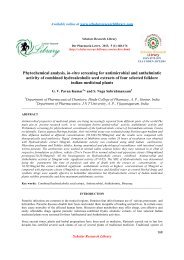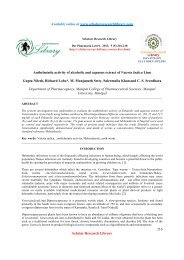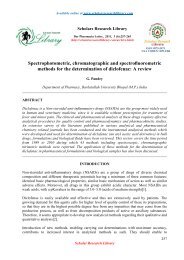Synthesis and evaluation of analgesic activity of novel series of ...
Synthesis and evaluation of analgesic activity of novel series of ...
Synthesis and evaluation of analgesic activity of novel series of ...
Create successful ePaper yourself
Turn your PDF publications into a flip-book with our unique Google optimized e-Paper software.
Available online at www.scholarsresearchlibrary.com<br />
Scholars Research Library<br />
Der Pharmacia Lettre, 2012, 4 (5):1431-1437<br />
(http://scholarsresearchlibrary.com/archive.html)<br />
ISSN 0975-5071<br />
USA CODEN: DPLEB4<br />
<strong>Synthesis</strong> <strong>and</strong> <strong>evaluation</strong> <strong>of</strong> <strong>analgesic</strong> <strong>activity</strong> <strong>of</strong> <strong>novel</strong> <strong>series</strong> <strong>of</strong> Indole<br />
derivatives linked to isoxazole moiety<br />
Dilli Varaprasad. E, Mastan. M*, Sobha Rani. T<br />
Dravidian University, Kuppam-517425, Andhra Pradesh, India<br />
_____________________________________________________________________________________________<br />
ABSTRACT<br />
A new <strong>series</strong> <strong>of</strong> 4-(3-(3-(4-substituted phenyl)-4, 5-dihydroisoxazol-5-yl)-1H-indol-2-yl) phenol (5a-5f) were<br />
synthesized for <strong>analgesic</strong> <strong>activity</strong>. Compounds 5b, 5c <strong>and</strong> 5d have significant <strong>analgesic</strong> <strong>activity</strong> <strong>of</strong> this <strong>series</strong>. All<br />
compounds were screened in vivo for their <strong>analgesic</strong> <strong>activity</strong> <strong>and</strong> acute toxicity studies. The structural assignment <strong>of</strong><br />
these compounds has been made on the basis <strong>of</strong> elemental analysis, IR <strong>and</strong> 1 H-NMR, LCMS data.<br />
Key words: Analgesic <strong>activity</strong>, Indole derivatives, Isoxazole.<br />
_____________________________________________________________________________________________<br />
INTRODUCTION<br />
Indole alkaloids have been proved to be medicinally important natural compounds. Indole ring constitutes an<br />
important template for drug design such as the classical NSAIDs indomethacin <strong>and</strong> indoxole. Further Indole<br />
derivatives have been reported to possess promising biological activities including <strong>analgesic</strong> 1 , antipyretic 2 ,<br />
antifungal 3 , anti-inflammatory 4-6 , anthelmintic 7 , cardiovascular 8 , anticonvulsant 9-10 ,antimicrobial 11-12 <strong>and</strong> selective<br />
COX-2 inhibitory activities 13-16 .Thus the efficient synthesis <strong>of</strong> <strong>novel</strong> substituted indole derivative compounds still<br />
represent highly pursued target. The substitution <strong>of</strong> heterocyclic moiety at the 3- position <strong>of</strong> Indole ring markedly<br />
influences the <strong>analgesic</strong> <strong>activity</strong>.<br />
Considering the above observations <strong>and</strong> in connection to previous publications involving the synthesis <strong>of</strong> new<br />
biologically active heterocycles 17 . I hope to report here in the synthesis <strong>of</strong> new 3- substituted indoles incorporating<br />
an extra heterocyclic ring such as Isoxazole to screen in vivo for their <strong>analgesic</strong> <strong>activity</strong> <strong>and</strong> acute toxicity studies.<br />
MATERIALS AND METHODS<br />
2.1. Animals<br />
The <strong>analgesic</strong> <strong>activity</strong> <strong>of</strong> newly synthesized compounds (5a-5f) was carried out on Male Swiss albino mice, body<br />
weight <strong>of</strong> 25-30 g. These animals were reared with robust health by providing st<strong>and</strong>ard pellet diet <strong>and</strong> water ad<br />
libitum in the animal house under st<strong>and</strong>ard environmental conditions <strong>of</strong> temperature, relative humidity, <strong>and</strong> 12 h<br />
dark/light cycle. After r<strong>and</strong>omization into various groups <strong>and</strong> before initiation <strong>of</strong> experiment, animals were<br />
acclimatized for one week. The animal experiments were previously approved by Institutional Ethical Committee<br />
(IEC) <strong>and</strong> followed CPCSEA requirements 18 .<br />
Scholar Research Library<br />
1431
Mastan. M et al Der Pharmacia Lettre, 2012, 4 (5):1431-1437<br />
_____________________________________________________________________________<br />
2.2. Materials<br />
The chemicals <strong>and</strong> solvents were purchased from commercial suppliers either from Aldrich, Spectrochem <strong>and</strong> they<br />
were used without purification prior to use. The melting points were determined in open capillary electronic<br />
apparatus. The IR spectra <strong>of</strong> synthesized compounds were recorded on IR Spectrophotometer using potassium<br />
bromide. The 1 H NMR were recorded in DMSO-d6 using NMR Bruker 300 MHz spectrometer <strong>and</strong> chemical shifts<br />
are reported as parts per million (ppm) using tetramethylsilane (TMS) as an internal st<strong>and</strong>ard <strong>and</strong> analyzed by mass<br />
spectra using Agilent. To monitor the reactions <strong>and</strong> to establish the identity <strong>and</strong> purity <strong>of</strong> reactants <strong>and</strong> products, thin<br />
layer chromatography (TLC) was performed on pre-coated plastic sheets <strong>of</strong> silica gel using different solvent systems<br />
<strong>and</strong> the spots were visualized by exposure to iodine, KmnO4 <strong>and</strong> UV chamber.<br />
Albino mice <strong>of</strong> either sex obtained from Central Animal Facility, Sree Siddaganga College <strong>of</strong> Pharmacy, Tumkur,<br />
were used for the study. The animals were acclimatized for a week <strong>and</strong> maintained under st<strong>and</strong>ard laboratory<br />
conditions, given free access to st<strong>and</strong>ard pelleted feed (M/s Pranava agro industries Sangli, Maharashtra <strong>and</strong> U.V.<br />
purified <strong>and</strong> filtered water, ad libitum. Tramadol (Trade name: Tramazac, Source: Zydus health care, B.N: ZHL<br />
4312, Mfg date: Dec 2011, Exp. Date: May 2014), Acetic acid 3% v/v, Indomethacin (Source: Research Lab fine<br />
Chem Industries, B.N: 99550509, Mfg date: May 2009, Exp. Date: May 2014).<br />
2.3. Scheme <strong>of</strong> synthesis<br />
The synthesis <strong>of</strong> the title compounds (5a-5f) is outlined in Fig.1. The required intermediate-2 was prepared by<br />
following vilsmeier-haack conditions; intermediate-3 was prepared by following Suzuki conditions. The obtained<br />
aldehyde compound (intermediate-3) further treated with different Para substituted acetophenones to obtain<br />
chalcones (4a-4f) by following Clasein-Schimdt reaction. The treatment <strong>of</strong> chalcones with hydroxylamine<br />
hydrochloride in presence <strong>of</strong> base resulted in the cyclization <strong>of</strong> α, β-unsaturated ketone into the title compound (5a-<br />
5f) in 60-70% yield after column purification. The purity <strong>of</strong> the compounds was checked by TLC in<br />
ethylacetate:hexane (3:7). The structures <strong>of</strong> the all the compounds were established by 1 H - NMR, IR, LCMS <strong>and</strong><br />
elemental analysis.<br />
Fig.1. Scheme <strong>of</strong> synthesis for 3-(4, 5-dihydroisoxal)-Indole derivatives<br />
i) DMF, POBr3, DCM, 45 O C, 1h ii) PdCl2 (dppf), Na2CO3, 1, 4-dioxane: H2O (5:1), 95 O C, 5h iii) Piperidine, Ethylene glycol, 160 O C, 6h iv)<br />
NH2OH.HCl, CH3COONa, Ethanol, 80 O C, 12h<br />
Scholar Research Library<br />
1432
Mastan. M et al Der Pharmacia Lettre, 2012, 4 (5):1431-1437<br />
_____________________________________________________________________________<br />
2.4. <strong>Synthesis</strong> <strong>of</strong> 2-Bromo-1H-indole-3-carbaldehyde (2)<br />
To a solution <strong>of</strong> dimethylformamide (0.68 mmol) in dichloromethane (10 mL) was added drop wise a solution <strong>of</strong><br />
phosphorus oxybromide (22.5 mmol) in dichloromethane (10 mL) at 0 o C. The white thick mixture was refluxed<br />
during 20 min, <strong>and</strong> then oxindole (7.5 mmol) was added portion wise. The mixture was stirred at reflux during 1h.<br />
Reaction was monitored by TLC. After completed the reaction, reaction mixture was quenched by addition <strong>of</strong><br />
crushed ice to the media. The mixture was stirred for 30 min, <strong>and</strong> then layers were separated. The aqueous layer was<br />
neutralized with solid potassium carbonate. The pale yellow precipitate which appeared was washed with cold<br />
water, solid material taken in dichloromethane dried over Na2SO4 <strong>and</strong> concentrated completely. After concentration<br />
<strong>of</strong> solvent pale yellow solid (1.34 g, 80%) was obtained.<br />
2-Bromo-1H-indole-3-carbaldehyde (compound 2)<br />
1 H NMR (DMSO-d6): δ 7.2- 8.0 (m, 4 H, Ar), 9.88 (s, 1H, CHO), 12.48 (brs, 1H, NH) MS: [M+2] m/z 226<br />
2.5. <strong>Synthesis</strong> 2-(4-Hydroxy-phenyl)-1H-indole-3-carbaldehyde (3)<br />
The mixture <strong>of</strong> compound-2 (4.46 mmol), phenyl boronic acid(4.9 mmol), Pd(dppf)Cl2(0.0002 mmol),Na2CO3 (8.9<br />
mmol) in dioxane:H2O(5:1) was heated to 90 o C under nitrogen atmosphere for 5h.Reaction was monitored by TLC.<br />
When reaction was completed the mixture was filtered through celite pad, washed with ethyl acetate, layers were<br />
separated. Organic layer was dried over Na2SO4, concentrated under reduced pressure. Crude compound was<br />
purified by column chromatography to obtained(0.74 g, 70%) as a brown color solid.<br />
2-(4-Hydroxy-phenyl)-1H-indole-3-carbaldehyde (compound 3)<br />
1 HNMR(DMSO-d6):δ 6.99-8.10 (m, 8H, Ar),12.2 (brs, 1H, NH),10.04(s,1H,CHO),9.9(S,1H,OH) MS:[M+H] m/z<br />
238<br />
2.6. General procedyre for synthesis <strong>of</strong> (E)-3-(2-(4-substitutedphenyl)-1H-indol-3- yl)-1-(4-substituted phenyl)<br />
prop-2-en-1-one (4a-4f)<br />
Indole-3-carbaldehyde (4.2 mmol), 4- substituted acetophenone (8.4 mmol) <strong>and</strong> piperidine (8.4 mmol) were mixed<br />
into 10 mL ethylene glycol. The solution was refluxed at 150-160 0 C for 5-6 h. The solution was cooled; diluted with<br />
water <strong>and</strong> extracted with ethylacetate. Organic layer was dried over Na2SO4 <strong>and</strong> concentrated <strong>and</strong> crude was<br />
purified by column chromatography to obtained ( 1.33 g, 68%, compound 4a) as a solid.<br />
The spectral analysis <strong>of</strong> the synthesized compounds is as follows:<br />
(E)-3-[2-(4-Hydroxy-phenyl)-1H-indol-3-yl]-1-(4-iodo-phenyl)-prop-2-en-1-one (compound 4a)<br />
1 H NMR (DMSO-d6): δ 7.59-7.64 (d, J=15.6Hz, 1H, =CH-Ar), 6.99-8.1 (m, 12H, Ar), 8.06 (d, J=15.9 Hz, 1H-<br />
COCH=), 12.2 (brs, 1H, NH), 10.01(s, 1H, OH) MS: [M+H] m/z 466<br />
(E)- 3-[2-(4-hydroxy-phenyl)-1H-indol-3-yl]-1-(4-Chloro-phenyl) - prop-2-en-1-one (compound 4b)<br />
1 H NMR (DMSO-d6): δ 7.46-7.48 (d, J=15Hz, 1H, =CH-Ar), 6.99-8.1 (m, 12H, Ar), 8.07 (d, J=15.6Hz, 1H-<br />
COCH=), 12.13 (brs, 1H, NH), 10.02(s, 1H, OH) MS: [M+H] m/z 374.6<br />
(E)-3-[2-(4-Hydroxy-phenyl)-1H-indol-3-yl]-1-(4-trifluoromethyl-phenyl)-prop-2-en-1-one (compound 4c)<br />
1 H NMR (DMSO-d6): δ 7.63-7.68 (d, J=15 Hz, 1H, =CH-Ar), 6.99-8.1 (m, 12H, Ar), 8.09 (d, J=15.3 Hz, 1H-<br />
COCH=), 12.18 (brs, 1H, NH), 10.02(s, 1H, OH) MS: [M+H] m/z 408<br />
(E)-3-[2-(4-Hydroxy-phenyl)-1H-indol-3-yl]-1-p-tolyl- prop-2-en-1-one (compound 4d)<br />
1 H NMR (DMSO-d6): δ 7.64-7.69 (d, J=15 Hz, 1H, =CH-Ar), 6.99-8.1 (m, 12H, Ar), 8.09 (d, J=15.3 Hz, 1H-<br />
COCH=), 12.07 (brs, 1H, NH), 9.99(s, 1H, OH), 2.45 (S, CH3) MS: [M+H] m/z 354<br />
(E)- 3-[2-(4-hydroxy-phenyl)-1H-indol-3-yl]-1-(4-Fluoro phenyl) - prop-2-en-1-one (compound 4e)<br />
1 H NMR (DMSO-d6): δ 7.63-7.68 (d, J=15 Hz, 1H, =CH-Ar), 6.99-8.1 (m, 12H, Ar), 8.06 (d, J=15.3 Hz, 1H-<br />
COCH=), 12.11 (brs, 1H, NH), 10.02 (s, 1H, OH) MS: [M+H] m/z 358<br />
(E)-3-[2-(4-Hydroxy-phenyl)-1H-indol-3-yl]-1-(4-nitro-phenyl) - prop-2-en-1-one (compound 4f)<br />
1 H NMR (DMSO-d6): δ 7.71-7.76 (d, J=15 Hz, 1H, =CH-Ar), 6.99-8.1 (m, 12H, Ar), 8.18 (d, J=15.3 Hz, 1H-<br />
COCH=), 12.3 (brs, 1H, NH), 10.1 (s, 1H, OH) MS: [M+H] m/z 385<br />
Scholar Research Library<br />
1433
Mastan. M et al Der Pharmacia Lettre, 2012, 4 (5):1431-1437<br />
_____________________________________________________________________________<br />
2.7. General procedure for <strong>Synthesis</strong> <strong>of</strong> 4-{3-[3-(4-substituted phenyl)-4, 5-dihydro-isoxazol-5-yl]-1H-indol-2yl}-phenol<br />
(compound 5a-5f)<br />
Chalcones (2.149 mmol, compound 4a), hydroxylamine hydrochloride (4.298 mmol) <strong>and</strong> sodium acetate (4.298<br />
mmol) were added in ethanol (10 mL) , the mixture was refluxed for 12 h. Reaction was monitored by TLC. The<br />
Mixture was concentrated by distilling out the solvent under reduced pressure. Crude was purified by column<br />
chromatography to obtained (0.67 g, 67%) as a solid. The spectral analysis <strong>of</strong> the synthesized compounds is as<br />
follows:<br />
4-{3-[3-(4-Iodo-phenyl)-4, 5-dihydro-isoxazol-5-yl]-1H-indol-2-yl}-phenol (compound 5a)<br />
IR (cm -1 , KBr): 3870, 3468, 3354, 1612, 1237, 1060, 591; 1 H NMR (DMSO-d6): δ 3.64 (dd, J=10.2 Hz, 1H, CH2<br />
isoxazoline), 3.82 (dd, J=11.1 Hz, 1H, CH2 isoxazoline), 5.96 (dd, J=10.8 Hz, 1H, CH isoxazoline), 6.91-7.88 (m,<br />
12H, aromatic), 11.39 (brs, 1H, NH),9.77(s,1H,OH) ; Anal. Calcd for C23H17IN2O2 C, 57.52; H, 3.57; N, 5.83; O,<br />
6.66 Found: C, 57.02; H, 3.65; N, 5.70; O, 6.20; MS: [M-H] m/z 479<br />
4-{3-[3-(4-Chloro-phenyl)-4, 5-dihydro-isoxazol-5-yl]-1H-indol-2-yl}-phenol (compound 5b)<br />
IR (cm -1 , KBr): 3359,3299, 1612, 1236, 1090, 739; 1 H NMR (DMSO-d6): δ 3.83 (dd, J=12 Hz, 1H, CH2<br />
isoxazoline), 3.89 (dd, J=12.6 Hz, 1H, CH2 isoxazoline), 5.96 (dd, J=10.8 Hz, 1H, CH isoxazoline), 6.92-7.8 (m,<br />
12H, aromatic), 11.4 (brs, 1H, NH),9.78(s, 1H, OH) ; Anal. Calcd for C23H17ClN2O2 C, 71.04; H, 4.41; Cl, 9.12; N,<br />
7.2; O, 8.23 Found: C, 70.80; H, 4.11; Cl, 9.22; N, 6.98; O, 8.11 MS: [M+H] m/z 389<br />
4-{3-[3-(4-Trifluoromethyl-phenyl)-4,5-dihydro-isoxazol-5-yl]-1H-indol-2-yl}-phenol (compound 5c)<br />
IR (cm- 1 , KBr): 3369, 2923, 1609, 1259, 1165, 1062, 1124; 1 H NMR (DMSO-d6): δ 3.73 (dd, J=12 Hz, 1H, CH2<br />
isoxazoline), 3.88 (dd, J=12.6 Hz, 1H, CH2 isoxazoline), 5.97 (dd, J=10.8 Hz, 1H, CH isoxazoline), 6.6-8.1 (m,<br />
12H, aromatic), 11.56 (brs, 1H, NH),9.82(s,1H,OH) ; Anal. Calcd for C24H17F3N2O2 C, 68.24; H, 4.06; N, 6.63; O,<br />
7.58 Found: C, 68.11; H, 4.10; N,6.57; O,7.32 MS: [M+H] m/z 423<br />
4-[3-(3-p-Tolyl-4, 5-dihydro-isoxazol-5-yl)-1H-indol-2-yl]-phenol (compound 5d)<br />
IR (cm- 1 , KBr): 3358, 3274, 2917, 1609, 1235, 1438, 1070; 1 H NMR (DMSO-d6): δ 3.63 (dd, J=12 Hz, 1H, CH2<br />
isoxazoline), 3.82 (dd, J=12.6 Hz, 1H, CH2 isoxazoline), 5.93 (dd, J=10.8 Hz, 1H,CHisoxazoline),6.91-<br />
7.67(m,12H,aromatic),11.37(brs,1H,NH),9.77 (s,1H,OH),2.37(s,3H,CH3); Anal. Calcd for C24H20N2O2 C, 78.24; H,<br />
5.47; N, 7.60; O, 8.68 Found: C, 78.31; H, 5.24; N, 7.57; O, 8.71 MS: [M+H] m/z 369<br />
4-{3-[3-(4-Fluoro-phenyl)-4, 5-dihydro-isoxazol-5-yl]-1H-indol-2-yl}-phenol (compound 5e)<br />
IR (cm- 1 , KBr): 3094, 2930, 1602, 1237, 1017, 1099; 1 H NMR (DMSO-d6): δ 3.8 (dd, J=12 Hz, 1H, CH2<br />
isoxazoline), 3.87 (dd, J=12.6 Hz, 1H, CH2 isoxazoline), 5.9 (dd, J=10.8 Hz, 1H, CH isoxazoline), 6.9-7.9 (m, 12H,<br />
aromatic), 11.3 (brs, 1H, NH),9.79 (s,1H,OH) ; Anal. Calcd for C23H17FN2O2 C, 74.18; H, 4.6; N, 7.52; O, 8.59<br />
Found: C, 74.22; H, 4.42; N,7.32; O,8.41 MS: [M-H] m/z 371<br />
4-{3-[3-(4-Nitro-phenyl)-4, 5-dihydro-isoxazol-5-yl]-1H-indol-2-yl}-phenol (compound 5f)<br />
IR (cm- 1 , KBr): 3394, 3261, 1605, 1510, 1342, 1256, 1095; 1 H NMR (DMSO-d6): δ 3.75 (dd, J=12 Hz, 1H, CH2<br />
isoxazoline), 3.89 (dd, J=12.6 Hz, 1H, CH2 isoxazoline), 5.98 (dd, J=10.8 Hz, 1H, CH isoxazoline), 6.8-8.1 (m,<br />
12H, aromatic), 11.5 (brs, 1H, NH),9.8(s,1H,OH) ; Anal. Calcd for C23H17N3O4 C, 69.17; H, 4.29; N, 10.52; O,<br />
16.02% Found: C, 69.23; H, 4.15; N,10.39; O,15.89 MS: [M+H] m/z 398<br />
Table 1 Physical data <strong>of</strong> the newly synthesized 3-(4, 5-dihydro isoxazole)-indole derivatives (5a-5f)<br />
Compound R1 Molecular Weight MP ( 0 C) Yield (%) Rf values<br />
5a I 480.31 228-230 65 0.50<br />
5b Cl 388.86 236-238 68 0.56<br />
5c CF3 422.41 211-213 70 0.45<br />
5d CH3 368.44 199-202 65 0.50<br />
5e F 372.4 110-113 60 0.53<br />
5f NO2 399.41 225-227 62 0.58<br />
Scholar Research Library<br />
1434
Mastan. M et al Der Pharmacia Lettre, 2012, 4 (5):1431-1437<br />
_____________________________________________________________________________<br />
3. Biological screening for synthesized compounds (5a-5f)<br />
Animal experimentation:<br />
Test substance:<br />
The test compounds titled as 5a, 5b, 5c, 5d, 5e <strong>and</strong> 5f were screened for the <strong>analgesic</strong> <strong>activity</strong> in mice at the dose <strong>of</strong><br />
10 mg/kg. All the st<strong>and</strong>ard drug <strong>and</strong> test compounds were dissolved in 0.1% DMF <strong>and</strong> further made it into<br />
suspension by using 1% Tragacanth in water.<br />
Tail immersion method 18 : Swiss Albino mice were fasted for 12 hours <strong>and</strong> r<strong>and</strong>omly allocated to eight groups <strong>of</strong> 5<br />
mice. Each mouse tail was dipped at a depth <strong>of</strong> 3 cm from the tip into a thermo regulated water bath containing<br />
warm water maintained at the temperature <strong>of</strong> 56 ± 2°C <strong>and</strong> the time taken for a mouse to withdraw the tail known as<br />
the pain reaction time (PRT) was recorded for all the mice, in 0.01 s units using a stopwatch. The cut <strong>of</strong>f time was<br />
10 s. Group I served as control <strong>and</strong> received vehicle only (10 ml/kg b.w), Group II to VII administered with the test<br />
substances 5a, 5b, 5c, 5d, 5e <strong>and</strong> 5f respectively (10 mg/kg b.w.) <strong>and</strong> Group VIII received tramadol (50 mg/kg b.w.)<br />
p.o.. PRT was recorded for all the mice at 0.5, 1, 2 <strong>and</strong> 3h post treatment. The withdrawal time <strong>of</strong> untreated animals<br />
is between 1 <strong>and</strong> 5.5 s. the increase in mean reaction withdrawal time <strong>and</strong> percentage <strong>of</strong> protection was calculated.<br />
Abdominal writhing test using acetic acid in mice 19 : Mice were fasted for 12 hours <strong>and</strong> r<strong>and</strong>omly divided to<br />
eight groups <strong>and</strong> n=5. Group I served as control <strong>and</strong> received vehicle alone (10 ml/kg b.w), Group II to VII treated<br />
with the test substances 5a, 5b, 5c, 5d, 5e <strong>and</strong> 5f respectively (10 mg/kg b.w.) <strong>and</strong> Group VIII received<br />
indomethacin (10 mg/kg b.w.) via oral route. Writhings were induced i.p. administration <strong>of</strong> 3% v/v acetic acid at a<br />
dose <strong>of</strong> 1 ml/100 g b.w., 30 min post treatment. The number <strong>of</strong> writhes was counted from 0 to 30 min after acetic<br />
acid injection. Percentage protection was calculated for all the groups by applying the formula: (Writhings in control<br />
- Writhings in test)/Writhings in control X 100.<br />
Scholar Research Library<br />
1435
Mastan. M et al Der Pharmacia Lettre, 2012, 4 (5):1431-1437<br />
_____________________________________________________________________________<br />
Table-1 Analgesic index (values in parenthesis) <strong>of</strong> compounds 5a, 5b, 5c, 5d,5e, <strong>and</strong> 5f evaluated by tail immersion method<br />
Treatment<br />
Reaction time in seconds<br />
(Dose mg/kg. p.o.)<br />
0 min 30 min 60 min 120 min 180 min<br />
Positive control (saline treated) 3.24 ± 0.61 4.41 ± 1.11 1.48 ± 0.42 1.11 ± 0.14 2.35 ± 1.07<br />
%change (26.58) (-118.91) (-190.58) (-37.69)<br />
5a (10 mg/Kg) 4.6 ± 0.73 2.15 ± 0.37 1.74 ± 0.58 4.61 ± 1.45 3.47 ± 2.17<br />
%change (-114.02) (-164.06) (0.15) (-32.68)<br />
5b (10 mg/Kg) 4.26 ± 0.42 4.79 ± 1.80 a 6.12 ± 2.23 c 6.98 ± 1.91 c 5.36 ± 1.67<br />
%change (11.04) (30.31) (38.88) (20.49) b<br />
5c (10 mg/Kg) 4.37 ± 0.69 6.24 ± 1.28 5.46 ± 2.19 b 5.22 ± 1.94 a 4.44 ± 1.98<br />
%change (29.97) c (19.94) (16.18) (1.57)<br />
5d (10 mg/Kg) 4.13 ± 0.83 4.20 ± 0.80 4.29 ± 1.93 7.81 ± 2.16 c 5.28 ± 1.65<br />
%change (1.47) (3.72) (47.01) (21.70)<br />
5e (10 mg/Kg) 2.40 ± 0.26 2.96 ± 0.85 1.04 ± 0.16 1.62 ± 0.52 1.43 ± 0.16<br />
%change (18.78) (-131.53) (-47.91) (-67.45)<br />
5f (10 mg/Kg) 1.81 ± 0.30 3.14 ± 0.89 0.78 ± 0.04 1.22 ± 0.27 4.61 ± 1.80<br />
%change (42.35) (-132.05) (-47.75) (60.73)<br />
Tramadol (50 mg/kg) 2.91 ± 0.32 4.29 ± 1.90 c 9.60 ± 0.31 c 6.38 ± 2.09 c 3.88 ± 2.04 b<br />
%change (32.02) (69.61) (54.26) (24.85)<br />
Values are expressed in MEAN±S.E.M. n=5. (Parenthes is value indicates % protection) ANOVA followed by Tukeys multiple comparison test.<br />
Values are statically a p
Mastan. M et al Der Pharmacia Lettre, 2012, 4 (5):1431-1437<br />
_____________________________________________________________________________<br />
CONCLUSION<br />
Various derivatives <strong>of</strong> 4-(3-(3-(4-substituted phenyl)-4,5-dihydroisoxazol-5-yl)-1H-indol-2-yl)phenol (5a-5f) were<br />
successfully synthesized <strong>and</strong> screened for their <strong>analgesic</strong> <strong>activity</strong>. The tested compounds 5b, 5c <strong>and</strong> 5d have<br />
significant <strong>analgesic</strong> <strong>activity</strong>. In acetic acid induced writhing test oral administration <strong>of</strong> 5a, 5b, 5c, 5d, 5e, <strong>and</strong> 5f<br />
significantly inhibited number <strong>of</strong> writhings as compared to acetic acid alone, indicates all the tested compound have<br />
<strong>analgesic</strong> <strong>activity</strong>.<br />
REFERENCES<br />
[1] Kameyama, T., Amanuma, F., Okuyama, S., Higuchi, S., Aihara, H., J Pharmacobiodyn 1985, 8, 477-486.<br />
[2] Bredt, A.B., Girey, G.J., Cancer 1982, 50, 1430-1433.<br />
[3] Sridhar, S.K., P<strong>and</strong>eya, S.N., Bajpai, S.K., Manjula, H., Indian Drugs 1999, 36, 412-414.<br />
[4] Kumar, A., Archana, Sharma, S., Malik, N., Sharma, P., Kushik,K. et al., Indian J Chem 2004, 43B, 1532-1536.<br />
[5] Singh, N., Bhati, S.K., Kumar, A., Eur J Med Chem 2008, 43, 2597- 2609.<br />
[6] Radwan, M.A.A., Ragab, E.A., Sabry, N.M., El-Shenawy, S.M., Bioorg Med Chem 2007, 15, 3832-3841.<br />
[7] Danilo Davyt, Walter Entz, Rafael Fern<strong>and</strong>ez, Raúl Mariezcurrena, Alvaro W. Mombrú, Jenny Saldaña, et al., J<br />
Nat Prod 1998, 61, 1560-1563.<br />
[8] Kumar, A., Saxena, K.K., Gurtu, S., Sinha, J.N., Shanker, K., Indian Drugs 1986, 24, 1-5.<br />
[9] El- Gendy Adel, A., Abdou Naida, A., El-Taber, Z.S., El-Banna Hosny, A., Alex<strong>and</strong>ria, J Pharm Sci 1997, 7, 99-<br />
103.<br />
[10] Gitto, R., De Luca, L., Ferro, S., Citraro, R., De Sarro, G., Costa, L., et al., Bioorg Med Chem 2009, 17, 1640-<br />
1647.<br />
[11] Trivedi, B., Shah, V.H., J Indian Chem Soc 1993, 70, 645-648.<br />
[12] Bhusare, S.R., Shinde, A.B., Pawar, R.P., Vibhute, Y.B., Indian J Pharm Sci 2004, 2, 228-231.<br />
[13] Guo, W.H.Z., Yi, X., Guo, C., Chu, F., Cheng, G., Bioorg Med Chem 2003, 11, 5539-5544.<br />
[14] Kalgutkar, A.S., Crews, B. C., Rowlinson, S.W., Marnett, A.B., Kozak, K.R., Remmel, R.P., et al., Proc Natl<br />
Acad Sci 2000, 97, 925-930.<br />
[15] Hu,W., Guo, Z., Chu, F., Bai, A., Yi, X., Cheng, G., Li, J., Bioorg Med Chem 2003, 11, 1153-1160.<br />
[16] Caron, S., Vazquez, E., Stevens, R.W., Nakao, K., Koike, H., Murata, Y., J Org Chem 2003, 68, 4104-4107.<br />
[17] Kumar, V.T., G<strong>and</strong>hi, N., Baswaraj, R. Int journal <strong>of</strong> chemtech research 2010, vol-2, 1434-1440.<br />
[18] Vogel WH, Scholkens BA, S<strong>and</strong>ow J, Muller G, Vogel WF. Drug discovery <strong>and</strong> <strong>evaluation</strong>.2nd ed. New<br />
York: Springer-Verlag Berlin Heidelberg; 2002.697, 759-760.<br />
[19] Buzzi FC, Franzoi CL, Antonini G, Fracasso M, Filho VC Yunes RA et al. Eur J Med Chem 2009, 1-7.<br />
Scholar Research Library<br />
1437


